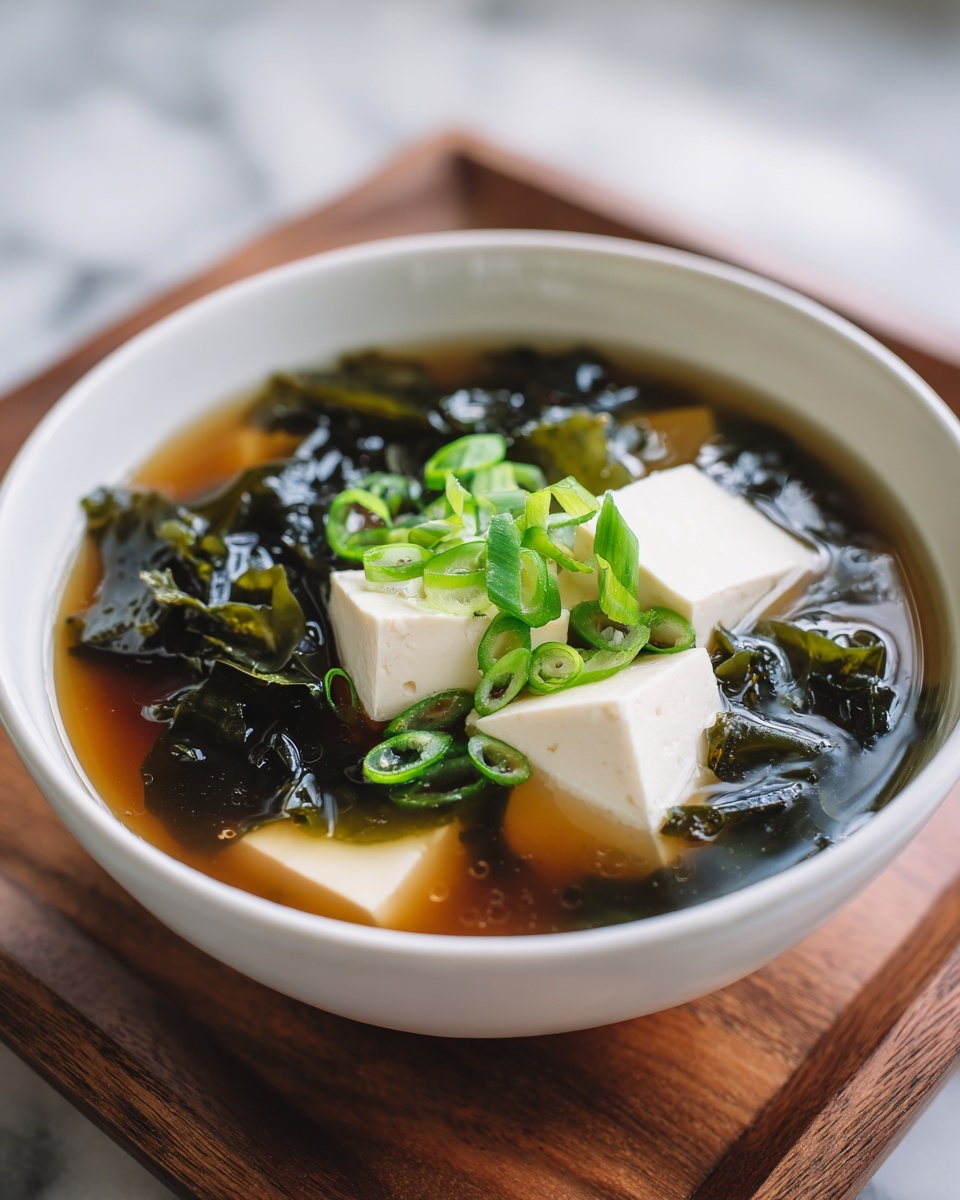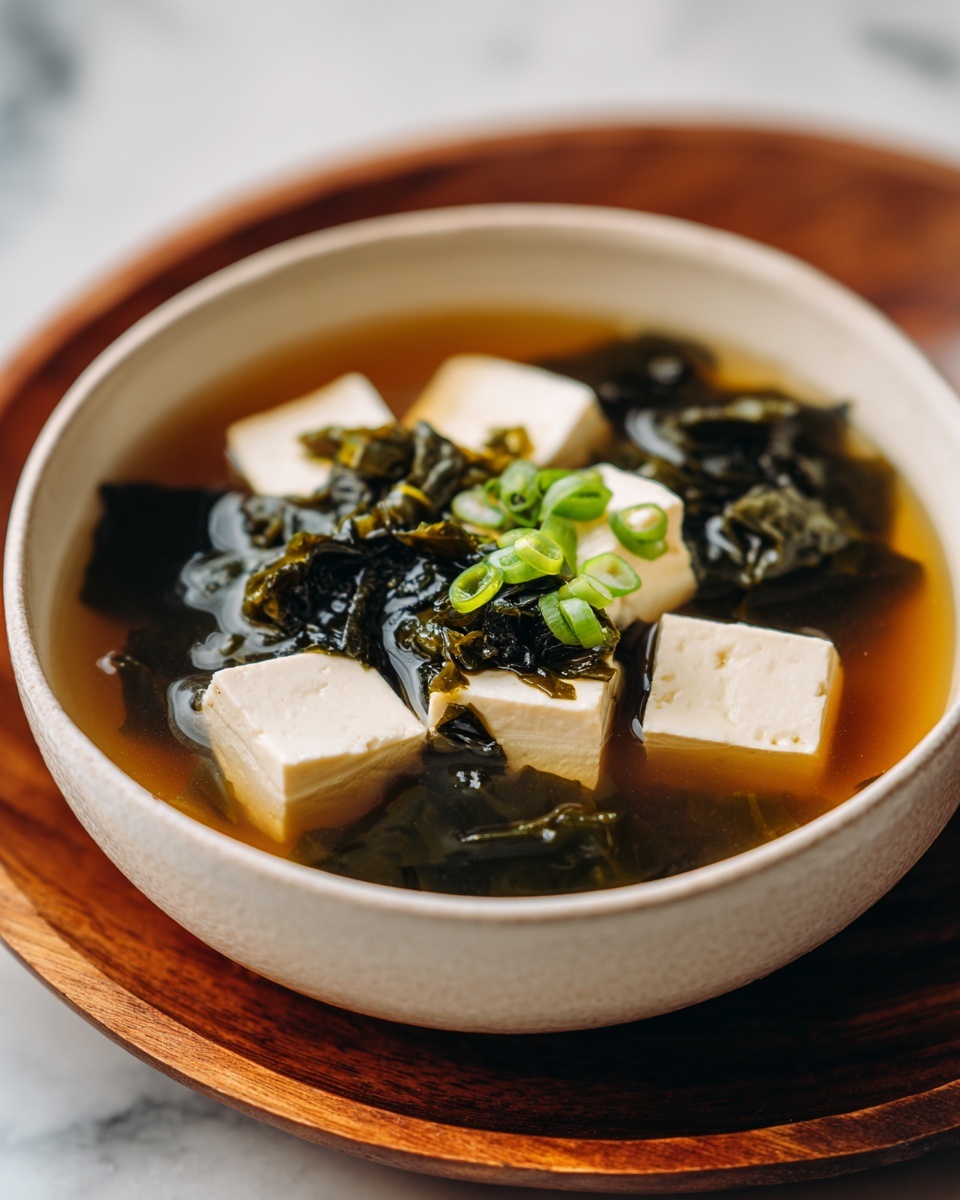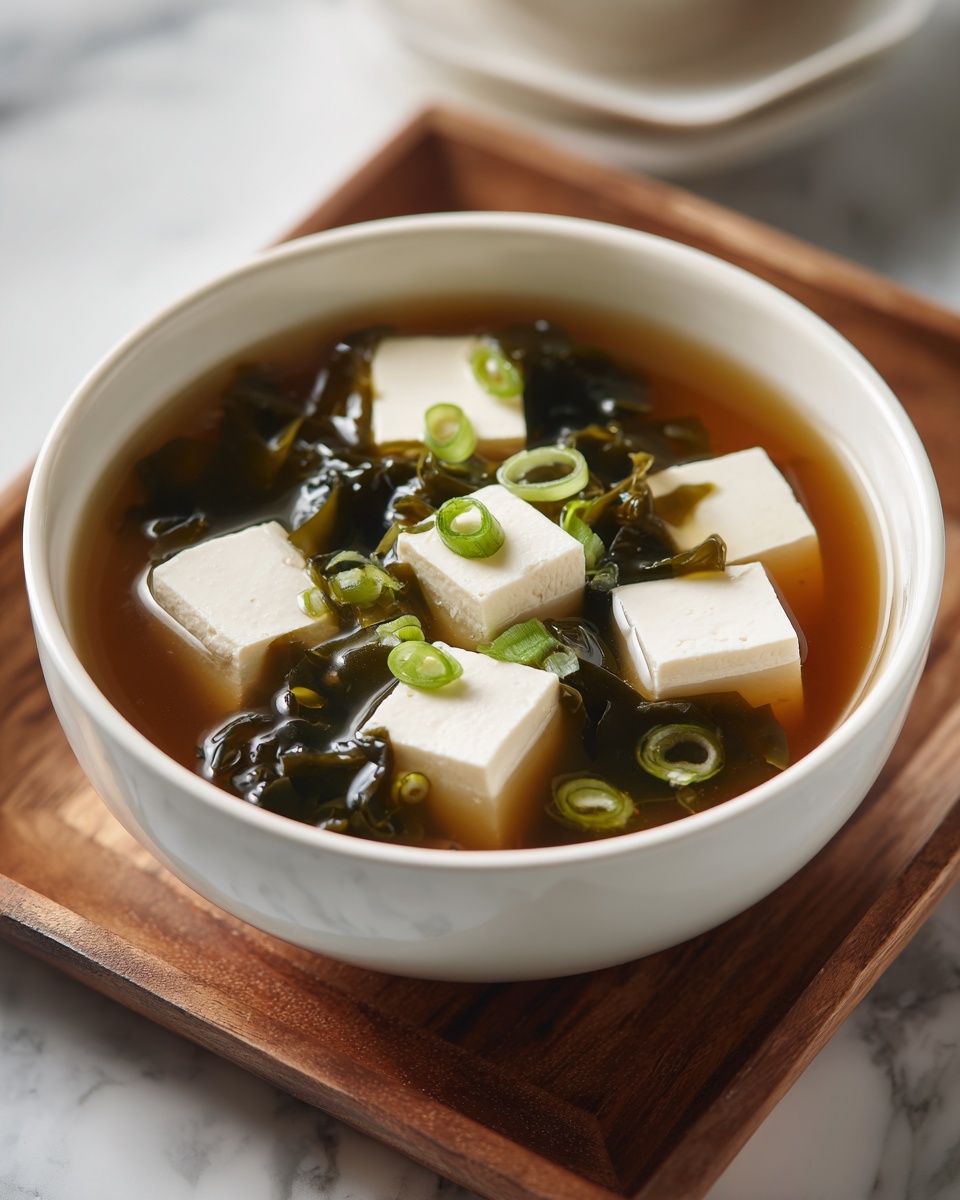If you have ever wondered how comforting and soul-soothing a simple bowl of miso soup can be, you are in for a treat with this Homemade Miso Soup with Tofu Recipe. This classic Japanese soup captures the delicate umami flavors of miso and kombu broth paired beautifully with soft tofu and a hint of green onion, making every spoonful warming and nourishing. It’s deceptively straightforward yet incredibly satisfying—a perfect dish to brighten any day or cradle you through a cozy mealtime.

Ingredients You’ll Need
Each ingredient in this Homemade Miso Soup with Tofu Recipe plays a vital role in building the soup’s authentic taste and inviting texture. From the seaweed’s subtle briny sweetness to the creamy tofu’s gentle softness, all elements come together harmoniously to create a bowl full of depth and comfort.
- 4 cups water: The pure base that carries all the flavors, essential for a light yet flavorful broth.
- 1 piece kombu (dried kelp), ⅓ oz, 4 x 4 inches: Adds a subtle, natural umami depth that sets the stage for the soup’s rich character.
- 1 cup katsuobushi (dried bonito flakes): Provides a smoky, savory note that rounds out the broth beautifully (skip if vegetarian).
- 7 oz soft/silken tofu (kinugoshi dofu): Offers a silky texture that perfectly contrasts the clear broth.
- 4 Tbsp miso paste: The heart of the soup, delivering that signature earthy, salty, and slightly sweet flavor.
- 1 Tbsp dried wakame seaweed: A burst of color and a tender, oceanic bite that enriches texture and taste.
- 1 green onion/scallion: Brightens the soup with a mild onion flavor and fresh crispness when sprinkled on top.
How to Make Homemade Miso Soup with Tofu Recipe
Step 1: Gather Your Ingredients
Start by collecting all your ingredients so you have everything at hand. This ensures the cooking process is smooth and you don’t miss any key components for that perfect broth.
Step 2: Prepare the Green Onion
Thinly slice one green onion or scallion into delicate rounds. These will add a refreshing crunch and vivid color contrast as a finishing touch to your soup.
Step 3: Make the Dashi Broth
Place 4 cups of water and the piece of kombu into a saucepan. Slowly heat until just before boiling to gently extract the kombu’s umami flavor, then remove the kombu to prevent bitterness. If you are not vegetarian, add the katsuobushi (bonito flakes), let them simmer briefly, then strain the mixture. This dashi broth forms the foundational rich taste that defines traditional miso soup.
Step 4: Combine and Cook the Soup
Pour your prepared dashi back into the pot and bring it to a gentle boil. Lower the heat and stir in the miso paste until fully dissolved—this step is crucial for maintaining miso’s delicate flavor and health benefits. Add the diced soft tofu, dried wakame, and sliced green onion. Allow the soup to warm through gently without boiling to keep the tofu tender and the miso’s flavor bright. Serve your homemade miso soup steaming hot.
How to Serve Homemade Miso Soup with Tofu Recipe

Garnishes
Enhance your bowl with extra thinly sliced green onions for freshness, a sprinkle of toasted sesame seeds for nutty crunch, or even a few thin strips of nori seaweed to boost both texture and flavor. Each garnish adds a personalized touch, making your Homemade Miso Soup with Tofu Recipe truly your own.
Side Dishes
This soup pairs wonderfully with a variety of sides like steamed white rice, pickled vegetables, or a light Asian salad with sesame dressing. These combinations balance the lightness of the soup and round out your meal with complementary flavors and textures.
Creative Ways to Present
For an impressive presentation, serve the soup in rustic earthenware bowls that keep it warm longer, or float delicate edible flowers or microgreens on top for a vibrant, eye-catching detail. You could even offer small dipping plates of soy sauce and chili oil for guests to customize their experience.
Make Ahead and Storage
Storing Leftovers
Store any leftover Homemade Miso Soup with Tofu Recipe in an airtight container in the refrigerator for up to 2 days. Keep in mind that the tofu and seaweed may absorb broth and soften further, so it’s best enjoyed fresh but still delightful when reheated gently.
Freezing
Freezing is not recommended for this miso soup due to tofu’s delicate texture and miso’s flavor nuances that may degrade. It’s best to prepare fresh or store leftovers in the fridge if needed.
Reheating
To reheat, warm the soup gently over low heat, stirring occasionally. Avoid boiling as it can dull the flavors and make the tofu grainy. Maintaining a gentle warmth preserves the soup’s delicate balance and silky texture.
FAQs
Can I make this miso soup vegetarian or vegan?
Absolutely! Simply omit the katsuobushi (dried bonito flakes) and rely on the kombu and miso paste to provide a rich vegetarian broth. Look for vegan-friendly miso pastes for a fully plant-based version.
What type of miso is best for this recipe?
White or yellow miso is ideal for this recipe due to their mildness and sweetness, which complement the tofu and seaweed without overpowering. However, feel free to experiment with red miso for a deeper, more pungent flavor.
How do I prevent my miso soup from becoming bitter?
Make sure not to boil the soup after adding miso paste. High heat can break down the delicate miso enzymes, leading to bitterness and a flat taste. Stir it in at low heat and warm gently instead.
Can I use firm tofu instead of silken tofu?
While silken tofu provides a soft, custardy texture that melts in your mouth, firm tofu can be used if you prefer a bit more bite. Just cut it into small cubes to help it absorb the broth flavors.
Is dried wakame necessary?
Wakame brings that subtle sea goodness and a bit of chewy texture that’s signature to miso soup. If you don’t have it, fresh seaweed or spinach can be alternatives, although the flavor and texture will differ slightly.
Final Thoughts
There is something truly magical about this Homemade Miso Soup with Tofu Recipe—its simple ingredients come together to make something greater than the sum of its parts, creating a bowl full of warmth and comfort. Whether you’re new to miso soup or a longtime fan, this recipe will quickly become a comforting staple you reach for again and again. So why not gather those few beautiful ingredients and give it a try? Your soul and taste buds will thank you!
Print
Homemade Miso Soup with Tofu Recipe
- Prep Time: 5 minutes
- Cook Time: 15 minutes
- Total Time: 20 minutes
- Yield: 4 servings
- Category: Soup
- Method: Stovetop
- Cuisine: Japanese
- Diet: Low Fat
Description
This homemade miso soup with tofu recipe offers a traditional Japanese comfort dish featuring a delicate dashi broth infused with kombu and bonito flakes, silky soft tofu, flavorful miso paste, wakame seaweed, and fresh green onions. Perfect as a light appetizer or a nourishing snack, this easy-to-make soup brings authentic umami flavors to your table in under 20 minutes.
Ingredients
Broth Ingredients
- 4 cups water
- 1 piece kombu (dried kelp), about ⅓ oz (10 g), approximately 4 x 4 inches (10 x 10 cm)
- 1 cup katsuobushi (dried bonito flakes), loosely packed (about 3 cups for stronger flavor)
Soup Ingredients
- 7 oz soft/silken tofu (kinugoshi dofu), cubed
- 4 Tbsp miso paste (approximately 18 g per 1 cup of dashi; total 4 Tbsp for this recipe)
- 1 Tbsp dried wakame seaweed
- 1 green onion/scallion, thinly sliced
Instructions
- Gather Ingredients: Assemble all the ingredients needed including water, kombu, bonito flakes, tofu, miso paste, dried wakame, and green onion.
- Prepare Green Onion: Thinly slice the green onion/scallion into rounds and set aside for garnishing the soup later.
- Make Dashi Broth: Place 4 cups of water and the kombu piece into a saucepan. Slowly heat over medium heat until just before boiling. Remove the kombu to avoid bitterness. If using non-vegetarian dashi, add the bonito flakes, let simmer briefly, then strain the broth to remove the flakes.
- Combine Soup Ingredients: Return the clear dashi broth to the pot and bring it to a gentle simmer. Add the miso paste and stir until fully dissolved without boiling the soup to preserve miso’s flavor. Gently add cubed soft tofu, dried wakame, and sliced green onions. Warm the soup for a few minutes until all ingredients are heated through.
- Serve: Ladle the miso soup into bowls immediately and enjoy while hot for authentic taste and texture.
Notes
- Do not boil the miso soup after adding miso paste to preserve its flavor and beneficial enzymes.
- For a vegetarian version, omit the bonito flakes and consider using only kombu dashi.
- Adjust miso quantity based on your taste preference for saltiness and intensity.
- Soak dried wakame in water for a few minutes beforehand if you prefer softer seaweed texture.
- Use soft or silken tofu for smooth texture; firm tofu can be substituted but alters mouthfeel.








